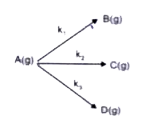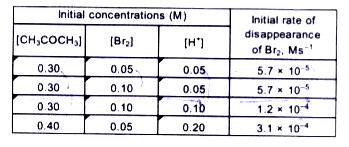LEVEL II from BRILLIANT PUBLICATION CHEMICAL KINETICS for Class 12
| Class 12 | CHEMISTRY |
| Chapter | CHEMICAL KINETICS |
| BRILLIANT PUBLICATION | LEVEL II |
| Medium | English |
| Academic Year | 2023-2024 |
Question 11
The kinetic data for the given reaction A (g) + 2 B (g) k−−→ C (g) is provided in the following table for three experiments at 300 K

In another experiment starting with initial concentration of 0.5 and 1 M respectively for A and B at 300 K, find the rate of reaction after 50 minutes from start of experiment (in M/sec). View SolutionQuestion 15
The gaseous decomposition reaction, A(g)→2B(g)+C(g) is observed to first order over the excess of liquid water at 25∘ C. It is found that after 10 minutes the total pressure of system is 188 torr and after very long time it is 388 torn The rate constant of the reaction (in hr1) is: [Given: vapour pressure of H2 O at 25∘ C is 28 torr(In 2 = 0.7, In 3 = 1.1, In 10 = 2.3)]View SolutionQuestion 16
A gaseous compound A reacts by three independent first order processes (as shown in figure) with rate . constant 2×10−3,3X10−3 and 1.93×10−3sec−1 for products B, C and D respectively. If initially pure A was taken in a closed container with P = 8 atm, then the partial pressure of B (in atm) after 100 sec from start of experiment.
 View Solution
View SolutionQuestion 17
A compound 'A' dissociate by two parallel first order paths atcertain temperature
A(g)k1(−1min)→2B(g)k1=6.93×10−3−1min
A(g)k2(−1min)→C(g)k2=6.93×10−3−1min
The reaction started whith 1 mole of pure A in 1 litre closed container with the initial pressure 2 atm what is the pressure (in atm ) developed in container after 50 minuts from start of experiment? View SolutionQuestion 18
The reaction cis- X⇌kbkf trans-X is first order in both directions. At 25∘ C, the equilibrium constant is 0.10 and the rate constant kf=3×10−4s−1 . In an experiment starting with the pure cis-form, how long would it take for half of the equilibrium amount of the trans-isomer to be formed?View SolutionQuestion 26
For a reaction A + B → C + D,if the concentration of A is doubled without altering the concentration of B the rate gets doubled. If the concentration of B is increased by nine times without altering the concentration of A, the rate gets tripled. The order of the reaction is:View SolutionQuestion 28
The decomposition of N2O5 according to the equation, 2N2O5(g)→4NO2(g)+O2(g) is a first order reaction, After 30 minutes from the start of the decomposition in a closed vessel, the total pressure developed is found to be 284.5 mm Hg and on completion, the total pressure is 584.5 mm Hg. Calculate the rate constant of the reaction.View SolutionQuestion 31
According to the collision model of kinetics, certain activtion energy must be overcome before a reaction can proceed. Based on the data given below, what is a reasonable estimate of the activation energy for the decomposition of NOCl ?
2NOCl(g)→2NO(g)+Clg
Temperature (K)Rate constant, k(L/mol s)4006.6×10−45002.9×10−16001.63×101View SolutionQuestion 32
The radioactive element, Thallium-201, is used medicinally as a radiotracer to study damage in heart tissue. If a patient is injected with a 0.950 g dose of pure Thallium-201, calculate the amount of time that would be required for the amount of Thallium-201 in the patient's body to reach 0.0500 g. Thallium-201 decays by a first order process with a half-life, t1/2=73.0 hrs.View SolutionQuestion 34
The metabolism of an antibiotic, A,is a first-order rate process. The rate constant, k, for this process depends on temperature and body weight, but for a 70 kg man at 37∘ C its value is k=3.0×10−5S−1 . How long after taking the first pill containing 400 mg of antibiotic must this man take the second pill to keep the concentration at 200 mg per 100 kg body weight? [ Asume instantaneous uniform distribution of the antibiotic throughout the body.]View SolutionQuestion 36
A first order reaction: A → Products and a second order reaction: 2R → Products both have half time of 20 min when they are carried out taking 4 mol L−1 of their respective reactants. The number of mole per litre of A and R remaining unreacted after 60 min from the start of the reaction, respectively, will beView SolutionQuestion 54
The reaction A→ X is a first order reaction which takes place in a vessel with initial concentration of A as 10 M. The rate constant for this reaction is 4.16h−1 . In the presence of a catalyst, the reaction A→Y follows second-order kinetics and the rate constant is 0.2 −1minM−1 . What should be the initial concentration of A in the presence of catalyst so that the value of t1/2 for both the reactions is the same? View SolutionQuestion 55
The activation energy of a reaction is 24.0 kcal mol−1 at 27∘C and the presence of catalyst changes its activation energy to one-fourth at the same temperature. The approximate ratio of rate in the presence of catalyst to rate in the absence of catalyst will be (use R = 2 cal mol−1K−1 ).View SolutionQuestion 74
Assertion :According to steady state hypothesis,in a multistep reaction, the change in concentration with time for reactive intermediates is zero.
Reason: The intermediates are so reactive that after a brief initial period their concentrations rise from zero to a small value and remains constant for most of the duration of reaction.View Solution
All Exercises from BRILLIANT PUBLICATION Class 12 CHEMISTRY CHEMICAL KINETICS
- QUESTION
- QUESTION (LEVEL - L) (HOMEWORK)
- QUESTION (LEVEL - L) (HOMEWORK) (ASSERTION- REASON)
- QUESTIONS
- LEVEL -I
- LEVEL I
- QUESTION (LEVEL - II)
- QUESTION (LEVEL - II) (ASSERTION - REASON)
- LEVEL -II
- LEVEL II
- LEVEL - III (LINKED COMPREHENSION TYPE )
- LEVEL - III (MATCHING COLUMN TYPE)
- LEVEL - III (MULTIPLE CORRECT ANSWER TYPE)
- LEVEL - III (NUMERICAL TYPE)
- LEVEL - III (SINGLE CORRECT ANSWER TYPE)
- LEVEL - III (STATEMENT TYPE)

